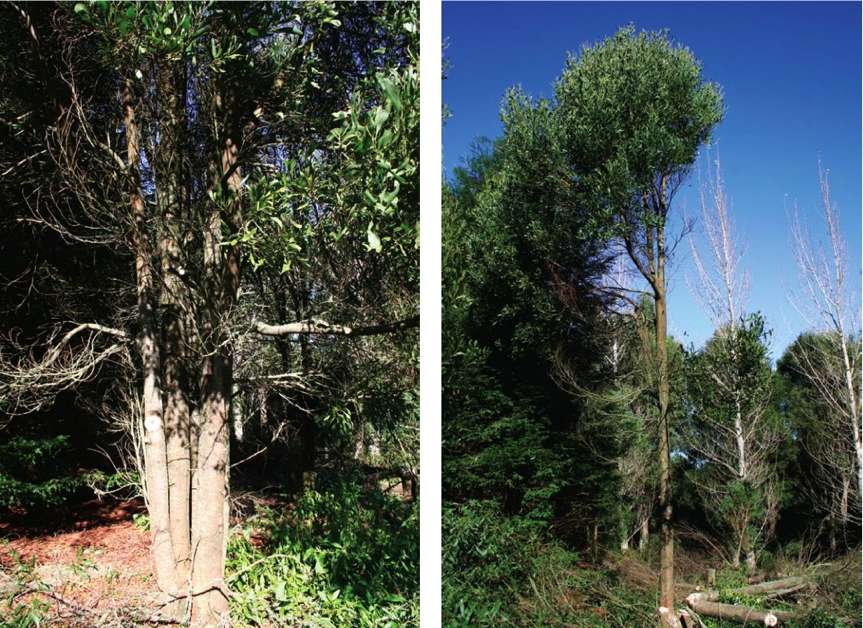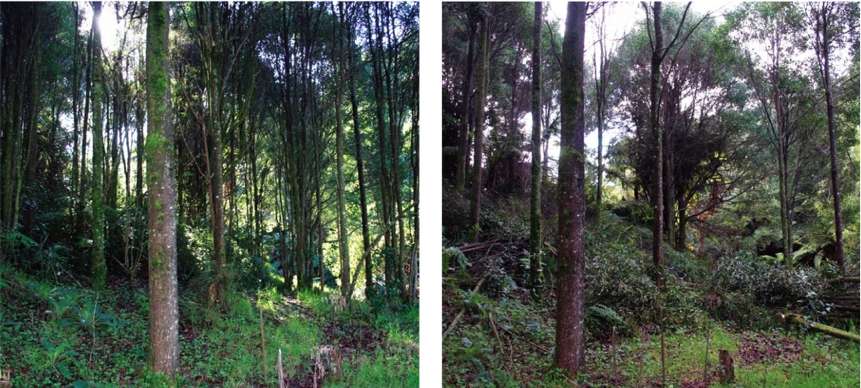Blackwood – let us not neglect coppice
Ian Brown, New Zealand Tree Grower August 2008.
Some years ago I caught up with Neil Barr at what must have been his last NZFFA conference in the Bay of Plenty. Neil was physically frail, but full of good humour, feisty and sharp as a tack. He was keen to discuss something I had written recently on natural blackwood regeneration, and after some encouragement he chided me for a neglect to mention coppice. Fortunately I was rescued by a pair of heavies – Branns, second crop – who popped him in a ute, and delivered him to the next stop. A few minutes later he was engaged in an old-fashioned robust debate with his great friend Geoff Brann in front of an audience of 300.
‘Geoff, that is not the way to prune pine trees!’
‘Neil, these are my trees, and I’ll prune them my way.’
Something has been missing from our conferences since that time.
In their natural habitat, blackwoods regenerate freely from ground-stored seeds after fire, and from disturbed roots. So why do they have the capacity for coppice? A common explanation is that this is an evolved response to predation by giant marsupials, recently extinct. I have been sympathetic to that theory after an encounter with one of them, a diprotodon, built like a small rhino and no doubt with an appetite to match, in the Melbourne museum.
A plague of cicadas
Some years previously I had my first, and unplanned, experience of coppice in blackwood. We had planted a group of blackwoods in Northland, and in their second summer they fell victim to a plague of cicadas. None of the stems were undamaged, and some of them covered in swarms of herringbone scars. In the following spring I selected the worst-affected trees, and cut them to a short stump. A year later the coppiced trees had produced a vigorous shoot, and had overtaken the rest, which had stalled, still weakened by the toxic scars from the previous summer.

Coppicing is a useful salvage option for blackwoods that are malformed from neglect, accident or predation. But is there an optimal season to cut in order to encourage coppice shoots? The European foresters, who for many centuries have used coppice silviculture in their deciduous hardwoods, have traditionally harvested in winter. At that time the dormant trees are loaded with nutrients in preparation for the spring flush. In contrast, eucalypts are normally coppiced in spring and summer. With persistent leaves, they can maintain photosynthesis and avoid the crash in nutrient reserves in spring that occurs in deciduous species. On the other hand, there are times when coppice is unwanted – when thinning in a plantation, or converting to another species or land use.
A coppice trial
Back in the late 1970s I was attracted to forestry after reading Neil Barr’s brilliant series of articles in the NZ Farmer. So after my meeting with Neil, and as an act of homage, or perhaps penance, I decided to atone for my ‘neglect of coppice’ by setting up a small trial at Pirongia.
The aim was to look at the response of coppice to season.
My son Martin and I planted 128 blackwood seedlings in two rows, extending up a hill. The trees were four abreast in each row and three metres between trees. At three years we allocated each tree in a group of four to a different season for coppice. To maintain a level playing field the selection was based on diameter. We coppiced each tree at a defined angle and height, of 12 cm, in successive seasons.
In summary, the results were –
- Winter High early mortality, six out of 32, shoots appeared at 12 weeks with good coppice growth on surviving trees.
- Spring Low early mortality, only one out of 32, shoots appeared sooner at six weeks with vigorous coppice growth.
- Summer Low early mortality, two out of 32, shoots appeared at eight weeks with slow coppice growth.
- Autumn High early mortality, five out of 32, and high late mortality with another four out of 32, shoots appeared in the following spring and there was poor height and diameter growth.
When measured three years later, the relative growth differences were maintained. The conclusion is that spring is the best season to encourage coppice growth in blackwood and autumn is the best season to reduce coppice.
Managing coppice
With eucalypts, the common practice is early thinning of coppice shoots. With blackwood, I think there is a good case for delayed thinning. The coppice shoots are closely packed, and compete with each other. This mimics the conditions that produce good form when they regenerate in their natural habitat, where they jostle for space in competition with other species. The coppice shoots tend to grow straight, and with good branch suppression. My approach is therefore to delay thinning until they have grown to eight or nine metres, and combine with light form pruning.
Coppice has sometimes been advocated as a method of choice in managing blackwood. It can produce acceptable trees with little effort, but there is a significant delay in rotation. I think it is better reserved for salvage.
A season for pruning
We tend to carry out silvicultural work whenever it suits our personal timetable. Perhaps we should give some thought to the biological clock that governs the life of a tree. In spring, the trees are primed for growth. Their roots have spread out into warm moist soil, the sap is rising, and the buds and shoots are buzzing with hormones. At this time of year the trees are best prepared to cope with any damage that we choose to inflict on them.
A few examples are given below:
- Coppice – spring for blackwoods and eucalypts and probably for other evergreen species, winter for deciduous hardwoods.
- Pruning – blackwoods have an indeterminate growth habit, and might be expected to compensate for loss of foliage during growth periods, by producing new shoots. A Forest Research study has shown a good growth response when blackwoods are pruned in spring, compared with winter.
- Branch shortening – if blackwood branches are shortened in winter, they will often die back. If shortened in spring, they are likely to respond by producing new shoots, and survive.
- Epicormics – these can be a problem when they appear in redwoods after pruning, and exposure to light. A recent study has shown that epicormics in redwoods are less frequent if pruning is carried out in autumn, rather than spring.
A season for bark stripping
In most tree species, the bark is adherent in winter, but strips readily in spring. People in Europe have taken advantage of this in activities as diverse as making walking sticks, or tanning leather. In the 18th century, there was a period in each summer when the rural school classrooms in England and Wales were empty for several weeks in summer. The children were out in the oak woods, stripping bark off the trees for the tanning industry.
Bark tearing is a problem in blackwood when large branches are pruned in late spring and summer. It can be avoided by pruning earlier in the growing season. But when ring-barking trees, the work is best done in spring, when the bark strips easily.


 Farm Forestry New Zealand
Farm Forestry New Zealand